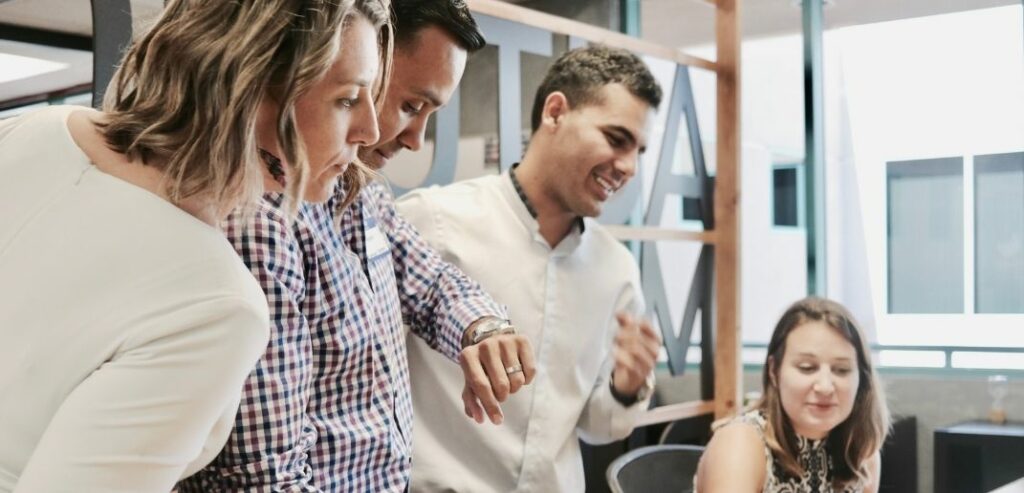
Collaborative recruiting: what it is, how and why to do it
Recruiting, unlike what is normally thought, can be managed collaboratively, and with excellent results. But what best practices and ways can be implemented to bring “team-based recruiting” to life? Find out in this article.
If you think of Steve Jobs, probably what your mind suggests, at first glance, are the “famous dots” that allow you in the present to connect what happened in the past and understand that after all there is a reason for everything. But the inventor of Apple and so many famous products uttered another phrase that relates to the recruitment process, namely:
You need to have a collaborative hiring process
And what is a collaborative hiring process? According to Jobs, it is the best way to hire talent. Recruitment is not – and should not be – the sole responsibility of the HR manager and the recruitment team, but can be a collaborative process involving other departments and other people.
In this article, we will try to understand what collaborative recruiting is, how to do it and, above all, why it is necessary to be collaborative in order to look for people who can make the company grow.
SUMMARY
- Collaborative recruiting: definition and meaning
- Best practices for collaborative recruiting in companies
- The advantages of collaborative recruiting
- The advantages of an ATS for collaborative recruiting
Collaborative recruiting: definition and meaning

Think for a moment about all the times you have started a recruting process and found a new talent: are all those times the same or do they differ? And again: have there been any unexpected and, why not, positive surprises?
We are sure you will say that everything was not uniform or even that it went as you planned because when dealing with people, variables are always around the corner. Therefore, there is no single way to recruit employees and collaborative recruiting can be very helpful here.
But what is it? If we wanted to give a definition, collaborative recruiting is a team recruitment methodology. That is to say, it involves several people who are not only HR people, but who work in other compartments.
Indeed, the aim is that it is almost a kind of teamwork whereby the whole process of finding and selecting new staff is shared. It is also referred to as team recruitment and this is because, like in a volleyball or football team – just to mention two sports that can give you an idea – everyone has a specific role that contributes to scoring a point or a goal.
This means that the different people in the company are involved from the screening of the CV through to the selection of the candidate, the interviews and the final evaluation.
This, of course, also affects the candidate’s own perception of the selection process: instead of meeting one or two people, he or she will see several and in this way will also get a truer idea of the company where he or she might go to work.
Having said that, let’s see how to actually carry out collaborative recruiting in the company.
Best practices for collaborative recruiting in companies

How to start collaborative recruiting in the right way? There are several ways or best practices that can be implemented.
Employee referral recruitment
One of these is employee referral recruitment. This is a strategic programme in which employees are encouraged to recommend, for one or more open positions, people who are part of their network and therefore might be suitable. As well as saving time and costs, this practice motivates employees to become an integral part of the recruitment process. This may be in return for recognition, bonuses, awards, etc…
Internal recruitment
Another equally valid and collaborative practice is internal recruitment or internal mobility. This basically consists of looking inwards rather than outwards because the best candidate may already be there.
And this is only possible if you build a collaborative culture in which all employees – but also collaborators, why not? – are aware of career opportunities and feel they can ‘dare’ to apply for a position other than the one they occupy. This practice not only saves time and money, but also plays a major role in building loyalty: knowing that they can try their hand at new activities and be considered for them makes people feel more ‘part of the whole’.
From the point of view of best practices, here are some more suggestions to make collaborative recruiting really meet the needs of the company.
Establish guidelines
Collaboration has to be trained, built, planned, that’s why nothing should be left to improvisation and guidelines should be established. Therefore, make sure that all the people involved in this activity know what they are doing and what their role is in the collaborative process.
So make sure you have a timetable with deadlines and meetings and don’t forget to define the ways in which this collaboration takes place. We know that it is not the tools that make the people, so the decision to use Microsoft Teams or Slack, to give two examples, must be a shared choice, as must that of the ATS software, which we will discuss in a moment.
At the stage when, for example, you identify a candidate and start writing the job description, it is important that there is a great deal of collaboration between the team where the person is going to work and HR. If, as an HR manager, you ask questions that will go unanswered because you use a channel that is little seen or you send several emails that “go unanswered”, this will not get you and your team off on the right foot. This is why choosing the ‘right’ communication channel is crucial.
Focus on training
Don’t take anything for granted and instead try to train the people in your team by showing them the best recruitment practices. You could do this by staging a mock recruitment exercise and asking each person in the collaborative recruitment team to put themselves on the candidate’s side. This way you will test how the process works and at the same time show them how to do it best.
Using the right tools
We have mentioned it before and we will say it again in a moment: ATS recruitment software such as Inrecruiting is essential for collaboration because of the many features it has that are aimed at sharing information.
The possibility of all accessing the same area, of distinguishing roles, of seeing what has been done up to that moment, helps the members of a team enormously, even more so if they are not strictly involved in selection. This is why, as we will see, collaborative recruiting is a must.
The advantages of collaborative recruiting
Before going into the details of ATS, let’s try to understand what are the advantages of working in collaborative mode when you are looking for new staff.
Improves the recruitment process and optimises costs
First of all, collaborative recruiting improves the recruitment process and leads to optimal results with less time and money spent. Involving more people allows you to have different points of view and above all to involve the people who will actually work with the newcomer. And this is a detail that should not be overlooked: no HR person can know the dynamics better than the person working on that project or with that client.
Improve the candidate experience

We have partly said this, but repetita iuvant. If a candidate has to deal with more people, they will have a much deeper understanding of both the company and its culture. Above all, he or she will see how certain values that a company tends to promote on its website or social channels are translated into the things it does.
Fosters employee engagement
With collaborative recruiting, people feel they are a living part of the company and not ‘relegated’ to doing their jobs. They have the feeling that they are participating in decisive processes and feel more valued and needed. This makes them more motivated and productive. And they avoid looking around for other jobs. Yes, collaborative recruiting is an employee retention strategy.
Improves corporate culture
Introducing collaborative recruiting helps to create a more open, transparent and collaborative company culture. This is beneficial in attracting both clients and partners who pay close attention to these aspects and talent. It works, therefore, in terms of Talent Attraction.
The advantages of an ATS for collaborative recruiting
And what are the advantages of using an ATS software such as Inrecruiting in a collaborative recruiting process? Many, indeed without such a tool, let’s say that such a collaborative process would lack a crucial element.
With ATS software you can:
- share candidate documents and CVs while saving time compared to managing them manually. You will say goodbye to lots of emails and have a “place” where everything is easily found and shared;
- easily manage the screening of CVs, make notes that others can read and understand how to choose the right candidate;
- define interview dates, trying to easily understand the availability of others as well as the candidate himself/herself to whom you will always give an answer, even if the interview does not take place;
- define interview dates, trying to easily understand the availability of others as well as the candidate himself/herself to whom you will always give an answer, even if the interview does not take place;
- organise the work in the best possible way and in all its parts, update in real time the various activities carried out by the team and know where you are in the hiring pipeline;
- manage the different company roles by defining the various functionalities and permissions that are associated with that role. In this way, not only will you make the process more streamlined but everyone will be clear on their duties.
Want to try collaborative recruiting with ATS software? Discover Inrecruiting.

Giornalista, content strategist e formatrice
Siciliana trapiantata a Milano, città che ama molto come la sua terra. Giornalista, SEO copywriter, formatrice e amante del live tweeting, scrive per varie testate e blog aziendali di lavoro, risorse umane e tanto altro.
Ha scritto nel 2020 il suo primo libro “Scrivere per informare” insieme a Riccardo Esposito, edito da Flacowski e nel 2021 altri due: “L’impresa come media” e “Content marketing per eventi“.
Ama il mare, la bici, la pizza, i libri, le chiacchiere all’aperto.